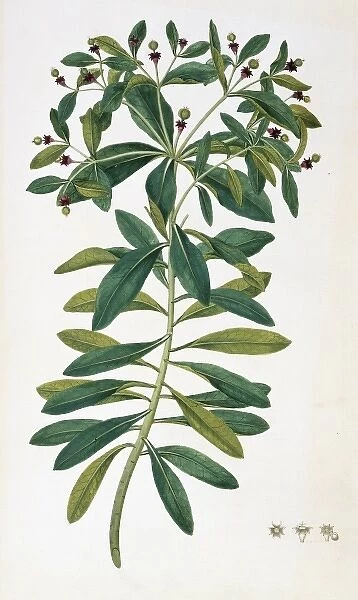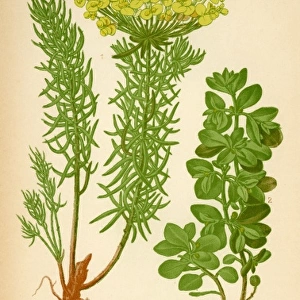Euphorbia glauca, sea spurge
![]()

Wall Art and Photo Gifts from Mary Evans Picture Library
Euphorbia glauca, sea spurge
Finished watercolour by Fred Polydore Nodder from an original outline drawing by Sydney Parkinson made during Captain James Cooks first voyage across the Pacific, 1768-1771
Mary Evans Picture Library makes available wonderful images created for people to enjoy over the centuries
Media ID 8617099
© Mary Evans Picture Library 2015 - https://copyrighthub.org/s0/hub1/creation/maryevans/MaryEvansPictureID/10706533
18th Century Australasia Captain Cook Captain James Cook Cook Endeavour Eudicot Euphorbia Euphorbiaceae Eurosid Fabidae First Fred Polydore Fred Polydore Nodder Malpighiales Milkweed New Zealand Nodder Angiospermae Dicot Dicotyledon Magnoliophyta Malpighiaceae
EDITORS COMMENTS
This stunning watercolour painting depicts Euphorbia glauca, commonly known as sea spurge, an intriguing member of the Euphorbiaceae family, which was meticulously illustrated during Captain James Cook's historic first voyage across the Pacific Ocean from 1768 to 1771. The original outline drawing was created by Sydney Parkinson, an accomplished artist and naturalist aboard the HMS Endeavour. The finished watercolour was later completed by Fred Polydore Nodder, a renowned botanical artist of the 18th century. Euphorbia glauca is a flowering plant native to New Zealand and Australasia, belonging to the Malpighiales order, Eudicots, and Angiosperms. Its distinctive features include the unique milky sap, which gives the plant its common name, and the alternating leaves with a waxy, blue-green surface. The plant produces small, greenish-yellow flowers in clusters, adding to its allure. The Euphorbiaceae family, also known as the spurge family, includes over 7,500 known species, many of which are found in tropical and subtropical regions. Euphorbia glauca is not to be confused with Euphorbia paralias, commonly known as the Devil's Backbone or Milkweed, which is a different species within the same family. This illustration offers a window into the natural history of the Pacific region during the Age of Discovery, showcasing the intricate details of a beautiful and intriguing flowering plant. The collaboration between Parkinson and Nodder highlights the importance of scientific exploration and the documentation of new discoveries during this era.
MADE IN THE USA
Safe Shipping with 30 Day Money Back Guarantee
FREE PERSONALISATION*
We are proud to offer a range of customisation features including Personalised Captions, Color Filters and Picture Zoom Tools
SECURE PAYMENTS
We happily accept a wide range of payment options so you can pay for the things you need in the way that is most convenient for you
* Options may vary by product and licensing agreement. Zoomed Pictures can be adjusted in the Cart.


